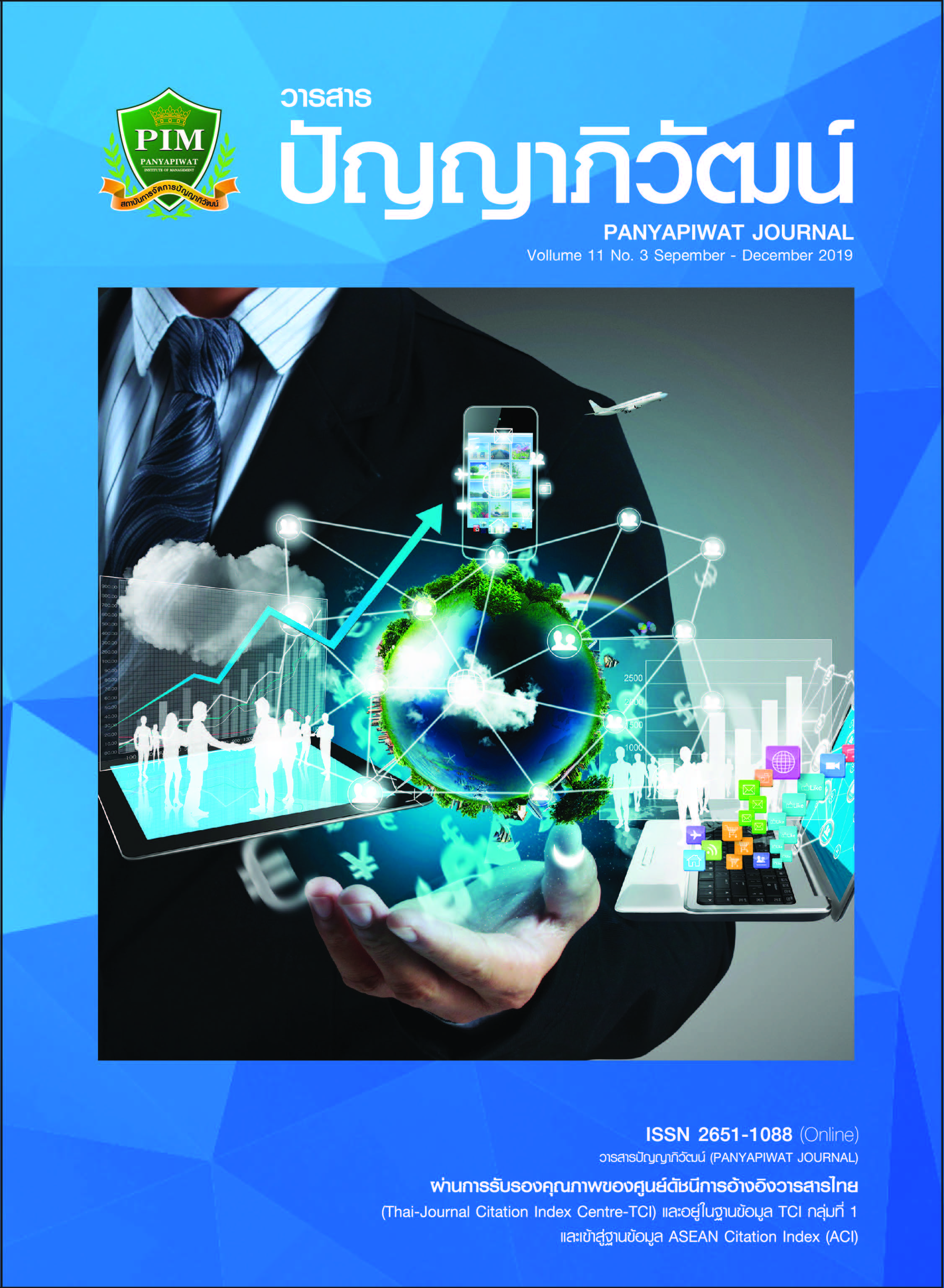การพัฒนารูปแบบการพัฒนาเขตเศรษฐกิจชายแดนที่ส่งผลต่อยุทธศาสตร์การก้าวเข้าสู่ประชาคมอาเซียนของตลาดการค้าชายแดนไทย-เมียนมา
Main Article Content
บทคัดย่อ
งานวิจัยนี้มีวัตถุประสงค์เพื่อศึกษาระดับความพร้อมในการพัฒนาเขตเศรษฐกิจชายแดน ระดับความสำเร็จในการดำเนินงานตามยุทธศาสตร์การเข้าสู่ประชาคมอาเซียน และพัฒนารูปแบบการพัฒนาเขตเศรษฐกิจขายแดนที่ส่งผลต่อความสำเร็จในการดำเนินงานตามยุทธศาสตร์การก้าวเข้าสู่ประชาคมอาเซียนของตลาดการค้าชายแดนไทย-เมียนมา โดยวิเคราะห์ข้อมูลด้วยโมเดลสมการโครงสร้าง (SEM) ประชากร ได้แก่ ผู้ประกอบการในตลาดการค้าชายแดน ไทย-เมียนมา ตามจุดผ่านแดนถาวร จำนวน 4 จุด ได้แก่ บริเวณสะพานข้ามแม่น้ำสาย บริเวณบ้านริมเมย บริเวณด่านตรวจคนเข้าเมืองระนอง และบริเวณบ้านพุน้ำร้อน กำหนดกลุ่มตัวอย่างใช้โปรแกรม G*Power3.1 ได้กลุ่มตัวอย่าง 498 คน การสุ่มตัวอย่างแบบหลายขั้นตอน (Multi-Stage Sampling) เครื่องมือที่ใช้ในการวิจัย ได้แก่ แบบสอบถามเกี่ยวกับระดับความพร้อมในการพัฒนาเขตเศรษฐกิจชายแดน และระดับความสำเร็จในการดำเนินงานตามยุทธศาสตร์การเข้าสู่ประชาคมอาเซียน สถิติที่ใช้ในการวิจัย ได้แก่ ค่าเฉลี่ย ส่วนเบี่ยงเบนมาตรฐาน และการวิเคราะห์โมเดลสมการโครงสร้าง ผลการวิจัยพบว่า ระดับความพร้อมในการพัฒนาเขตเศรษฐกิจชายแดนไทย-เมียนมา และระดับความสำเร็จในการดำเนินงานตามยุทธศาสตร์การก้าวเข้าสู่ประชาคมอาเซียนอยู่ในระดับปานกลาง ผลการวิเคราะห์โมเดลสมการโครงสร้างพบว่า ความพร้อมในการพัฒนาเขตเศรษฐกิจชายแดนไทย-เมียนมา ส่งผลต่อความสำเร็จในการดำเนินการตามยุทธศาสตร์การเข้าสู่ประชาคมอาเซียน ร้อยละ 91 โดยการพัฒนาเขตเศรษฐกิจชายแดน พัฒนาผู้ประกอบการให้สามารถพัฒนาธุรกิจ และเชื่อมโยงการพัฒนาเศรษฐกิจตามแนวพื้นที่ชายแดนส่งผลมากที่สุด
Article Details
“ข้าพเจ้าและผู้เขียนร่วม (ถ้ามี) ขอรับรองว่า บทความที่เสนอมานี้ยังไม่เคยได้รับการตีพิมพ์และไม่ได้อยู่ระหว่างกระบวนการพิจารณาลงตีพิมพ์ในวารสารหรือแหล่งเผยแพร่อื่นใด ข้าพเจ้าและผู้เขียนร่วมยอมรับหลักเกณฑ์การพิจารณาต้นฉบับ ทั้งยินยอมให้กองบรรณาธิการมีสิทธิ์พิจารณาและตรวจแก้ต้นฉบับได้ตามที่เห็นสมควร พร้อมนี้ขอมอบลิขสิทธิ์บทความที่ได้รับการตีพิมพ์ให้แก่สถาบันการจัดการปัญญาภิวัฒน์หากมีการฟ้องร้องเรื่องการละเมิดลิขสิทธิ์เกี่ยวกับภาพ กราฟ ข้อความส่วนใดส่วนหนึ่งและ/หรือข้อคิดเห็นที่ปรากฏในบทความข้าพเจ้าและผู้เขียนร่วมยินยอมรับผิดชอบแต่เพียงฝ่ายเดียว”
เอกสารอ้างอิง
Chaimadan, C. & Skunrat, S. (2015). Thai-Cambodian Border Trade Policy and its Adaptation to ASEAN Community: A Case Study of Sakhao Province. Ratchaphruek Journal, 13(2), 76-85. [in Thai]
Department of International Trade Promotion. (2015). Trade and Investment Guide Republic of the Union of Myanmar. Retrieved December 4, 2018, from https://www.aecthaibiz.com/aecadmin/uploads/20150506_111719.pdf [in Thai]
Kaewmanee, R. (2015). Bright border trade Opportunities of the industrial sector under the Thai baht fluctuation ASEAN. Retrieved September 7, 2015, from https://www.oie.go.th/sites/default/files/attachments/article/trendbordertrade-june2556.pdf [in Thai]
Nararak, W. (2016). The 12th National Economic and Social Development Plan for ASEAN. Retrieved November 19, 2016, from https://www.phetvayupakclub.com/www.moosiri.com/admin/upload_new_general/4668609.pdf [in Thai]
Office of the National Economic and Social Development Board. (2016). National Economic and Social Development Board No. 12 (2017-2021). Retrieved November 19, 2016, from https://www.nesdb.go.th/ewt_dl_link.php?nid=6422 [in Thai]
Raengsungnein, G. (2011). Factor Analysis with SPSS and AMOS for Research. Bangkok: Se-Education. [in Thai]
Silpcharu, T. (2007). Statistical analysis and research with SPSS and AMOS (7th ed.). Bangkok: V Inter Print. [in Thai]
Sooksawang, P. (2013). Structural Equation Modeling. Bangkok: Wattana Phanit Printing & Publishing. [in Thai]
Thai Business Information Center in Myanmar. (2018). Trade statistics between Thailand and Myanmar. Retrieved November 22, 2018, from https://www.thaibizmyanmar.com/th/thai-myanmar/trade-investment.php [in Thai]
The Government Public Relations Department. (2015). Border crossing Thai-Myanmar border. Retrieved December 4, 2018, from https://www.aseanthai.net/ewt_news.php?nid=2948&filename=aseanknowledge [in Thai]
Trakulruangsi, S. (2011). Analysis of potential and problems of Thai-Myanmar border trade: a case study of Mae Hong Son province. Education Report Faculty of Economics, Chiang Mai University. [in Thai]
Yuen, L. W. (2012). Capacity-building through English language training to improve long-term resettlement success: A case study of the refugees along the Thailand-Burma border. Electronic Theses and Dissertations, University of Denver.


